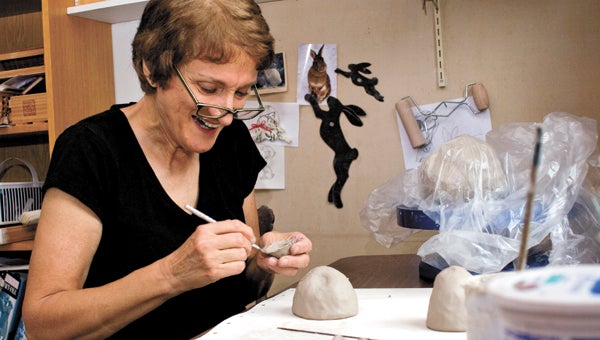A hands-on approach
Published 9:20 pm Friday, September 19, 2014

Janet Drew constructs a rabbit’s head — her current obsession — from clay in her home studio on a recent Saturday morning. She said she tries to get to the studio often, as it helps her relax.
Janet Drew’s workspace at her Lake Prince-area home has the mark of disorganization that seems to distinguish all artists’ workspaces.
Supplies and materials are scattered in empty tubs and jars that previously held butter, yogurt, sharp cheddar cheese spread and boysenberry preserves. Windowsills are populated with small plastic animals. Projects she wasn’t pleased with are laid out on trays — “If I don’t keep track of what I do, I’m liable to repeat it,” she explained — and the comparatively few projects that did meet her high standards are displayed on shelves.
“I’m probably my own worst critic,” she said.
Drew is a clay artist and retired elementary art teacher. Early in her career, she gravitated toward painting and took a class in clay only because of her job.
“Clay is something children really love,” she said. “Most children like clay because it’s so responsive. Whatever they do to it, it stays there.”
But through the class, Drew discovered she liked working with clay. She left painting in the dust — literally.
When it’s dry, the substance that forms clay is quite dusty. But once it’s mixed with water in exact quantities, it can be molded into just about any shape imaginable.
Drew has done cylinder shapes and slab work, but these days she’s fixated on animals — particularly rabbits.
“I make one, then I think of another way of doing it,” she said.
There are different techniques of working with clay. Even non-artists are probably familiar with the wheel, which can be used to make cylinders as the artist controls the spin of the wheel with a foot pedal and shapes the clay as it turns.
But for Drew’s rabbits and other animals, only hand-building and pinching will do.
“Depending on what you’re making, you have to choose a technique that’s going to get you where you want to go,” she said. “It’s best to get your ideas in order before you actually start.”
Drew makes the rabbits by starting with a large ball for the head, from which she cuts a cone and inverts it to make the snout, smoothing out the seams. From there she can make impressions for the eye sockets and put in eyes and eyelids.
“The eyes are fun to make, because the thing just comes alive when he has eyes,” she said.
Drew enjoys feeling the clay as she works, but sometimes it’s necessary to use tools. Her favorite is an old knitting needle she found in a chest she purchased from an antiques store.
“I think with certain techniques, you touch the clay more than with other techniques,” she said.
Not everybody likes the feeling of clay on their hands, though. In more than 30 years of teaching — first in Massachusetts, then in Virginia — she ran across some kids who couldn’t tolerate it.
“I’ve had kids that didn’t want to touch it,” she said. “They said it feels yucky.”
The feeling of clay on her hands and the quiet of her studio help relieve stress, Drew said. But even though she and her husband are both retired, it’s hard to find the time.
“I have to fight distractions,” she said. “If I can get half a day out here, I’m happy.”






